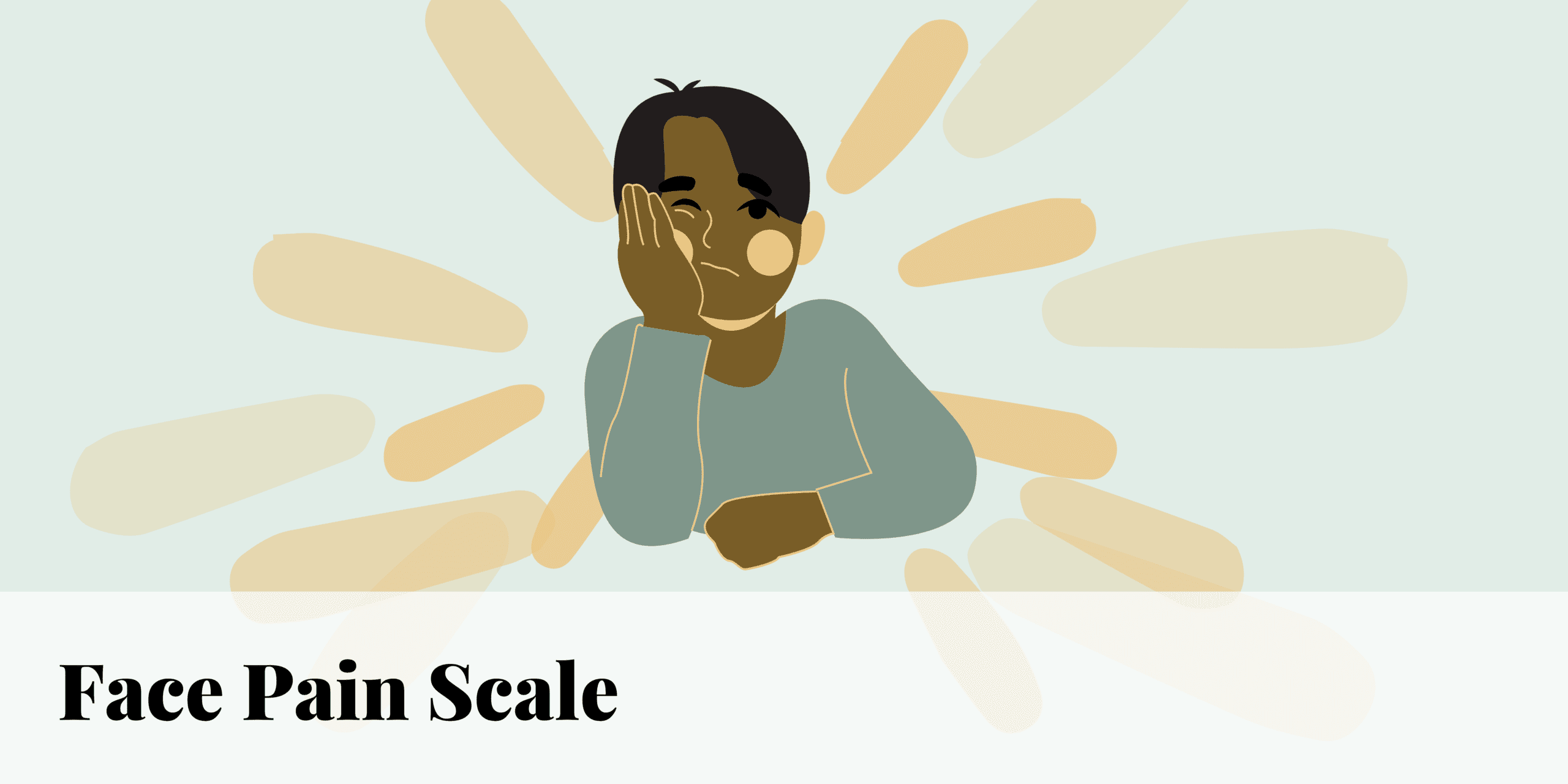
A faces pain scale was originally designed (with kids) for kids (above the age of three) to be able to describe their pain, as a self-reporting measure. The original pain scale faces had a total of seven faces (refer to Figure 1.) It was rated from a zero to six. A zero meant no pain and a six would mean maximum pain (6). It was intended to facilitate communication and improve assessment so the appropriate pain management can be addressed (7).

Figure 1 (6).
What is a Faces Pain Scale?
Faces Pain Scale-Revised
The Faces Pain Scale-Revised version was done by two individuals named Donna Wong and Connie Baker in 1983 (hence the name being changed to their last names). For simplicity’s sake, instead of saying Faces Pain Scale-Revised, it was renamed the Wong-Baker Faces or the Wong-Baker Scale (refer to Figure 2). The Wong-Baker Faces have six faces in total, in contrast to the original seven. It was designed to help children (three or older) self-report and effectively communicate about their pain. Once practitioners clearly understood the child’s pain, they could develop a quality treatment and support plan (7). The faces were also kept similar designs to maintain their psychometric properties (2).
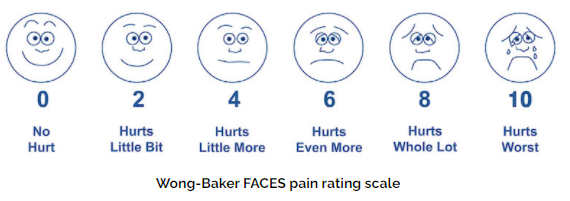
Figure 2 (7).
Faces Pain Scale
What is the Wong-Baker Faces Scale?
This pain scale uses a scale of zero to ten with the appropriate facial expressions. Face zero does not hurt at all. Two hurts just a little bit. Four hurts a little bit more. Six hurts even more. Eight hurt a lot. And finally, face ten hurts as much as you can imagine. Although, you do not have to be crying to have this worst pain even though the face has tears on its expression in face ten. The physician will ask the person to choose the face that best depicts the pain they are experiencing (7).
Understanding the Wong-Baker Faces Scale
The Wong-Baker Foundation, after launching in 1983, has derived their Wong-Baker pain scales for international use. It is highly widely used and not only for kids! Although the idea started with the pediatric population (for kids who are older than three years of age)- it can be used for adults and the elderly alike (especially patients who have language barriers, have an inability to count, or impaired brain function)(6)! Their foundation has released a printable PDF version of the full instructions and can be distributed amongst the healthcare community for usage. Feel free to use the printable pdf to your own advantage!
Why use the Pain Scale Faces?
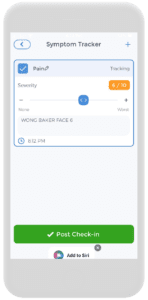
Okay, you know what pain scale faces are used for. But how would that help you? It can! Pain is an extremely common symptom in a lot of diseases or disorders. There is no chance, without a doubt, that you have not experienced pain in your lifetime! With that being said, pain is also a subjective finding. That means pain is described by YOU. It is not an objective finding similar to a test result or something that can be physically measured. It is important for pain assessment in any setting to have scientifically valid tools to determine the quality and intensity of pain, aid diagnosis, direct treatment, and evaluate effectiveness to help you accordingly (1).
The CareClinic Platform will allow you to track your pain using our Symptoms Tracker. Here, you can rate your pain daily on a scale of zero to ten as well as indicate which numerical value of Wong-Baker Faces you are at. If you look at the picture to the left, this is an example of a 6/10 or Wong-Baker Face 6 symptom tracking. You could also use the printable pdf to guide you as well.
People are often reluctant to use such a rating scale. But it is appropriate to incorporate it into your daily life! That way, you can stay on top of your symptoms and enhance your communication skills with your healthcare team. Let’s use the digital 21st century to help you take one step closer to your health goals!
When would it be inappropriate to use the Pain Scale Faces?
As good as it sounds, unfortunately, it is not used for everything. Firstly, the foundation states that it is not allowed to put color into the faces. “The focus of the scale is to assess pain and its simplicity works. The integrity of the scale’s reliability and validity is known for the version we provide” (7).
Secondly, it is also mentioned to never use the Wong-Baker Faces scale in trying to assess emotional and mental states. It is not modifiable as it has not been studied or authorized to be used for other clinical uses (other than for pain assessment) (7).
Thirdly, it is not a tool used by a third person, parents, healthcare professionals, or caregivers, to assess the patient’s pain. There are other tools for such purposes that need to be used for the correct measure. Please use your judgment and use it accordingly (7)!
Lastly, it is a self-assessment scale, so the “patient needs to be able to understand the instructions and select a face that illustrates the pain they are experiencing. It should never be used with unresponsive patients or to compare the patient’s face to the scale to determine the level of pain “(7).
Maybe, and here’s to hoping, that in the near future, other versions will be adapted to expand its uses in clinical settings. Perhaps the next person can be…you? Here’s to a better living and being optimistic together!
Visual Faces Pain
What is Visual Pain?
This is a weird phrase, right? Visual Pain? How on earth can you physically see pain? Well the simple answer, is you cannot. This is actually a scale that questionnaires or healthcare professionals can use, as well as using the pain scale faces. Visual pain scaling consists of a 100 mm unmarked line with standardized wording: ‘no pain’ on the left of the line, and ‘worst pain imaginable’ on the right. Then, the patient places a mark on the line corresponding to their level of pain. It remains the “gold standard” for most pain-related research (1). One of the disadvantages of this method is that it relies on the patient’s understanding and comprehension of the question which can skew results if done incorrectly. However, many studies have shown its efficacy and that it is sensitive in reporting the changes in pain (1, 2, 3, 5).
How can you use Visual Pain?
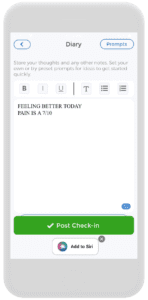
Since visual pain is a line from one end to another- that can be expressed using your words. This can be also used as an effective communication tool for both yourself as well as with your healthcare team. Using the Diary check-in function in the CareClinic Platform allows you to write anything you desire in your words. This way, you can log your own visual pain. You can rate it however you wish. The picture on the right indicates this patient who wrote about how much they were feeling better and rated their pain as a 7/10 (perhaps in contrast to a 10/10 that it may have been).
This keeps you in full control of your pain and other symptoms. Before these pain scales were invented, it was the time before cellphones and advanced technology. With every passing year, technology advances. And it will continue to do so! There is no slowing down anytime soon. So why not take advantage of what is currently in your hands right now? You are probably on your phone a lot during the day/night anyway… Why not use some of that allotted time to help you with your health?
Remember: either the Faces Pain Scale or the Visual Pain scaling system can be used for people of all ages! It is always appropriate to use it at any given time. So begin your journey today.
Faces Pain Rating Scale Reliability
Is the Face Pain Rating Scale Reliable?
The word reliability in research has a different meaning to it than the usual definition of reliable. When thinking of someone who is reliable, it means someone you can trust or rely on. Right? But reliability in science is totally different, yet kind of similar. Something is defined as having “reliability” if a method measures something consistently. Therefore, if the same result can be consistently achieved by using the same methods under the same circumstances, the measurement is considered “reliable” (4). However, as mentioned before, the Faces Pain Rating Scale Reliability has been tested consistently over a span of forty years. The Faces Pain Rating Scale Reliability has been seen to correlate with significant values with participants of all ages as an effective tool to measure pain (1, 2, 3, 5).
Reliability vs Validity
For the sake of being thorough, validity is also a term used in science. It is important to understand its meaning. “Validity refers to how accurately a method measures what it is intended to measure. If research has high validity, that means it produces results that correspond to real properties, characteristics, and variations in the physical or social world. High reliability is one indicator that measurement is valid. If a method is not reliable, it probably is not valid” (4). This basically means that the research is actually measuring what it is intended to measure. Which means what you are researching is actually “valid”. Reliability and validity work together to prove that whatever measure is a good tool for usage. Showing that you have taken both of them into account in planning your research and interpreting the results makes your work more credible and trustworthy.
Understandingly, that sounds like a bunch of gibberish. You are not a researcher (and if you are, then everything will probably make more sense right?). But not all of us are into this kind of stuff. But in short, the Face Pain Rating Scale has been shown to be BOTH valid and reliable in its constant reproducible results. It has again and again been shown to have positive correlations and successful in rating pain. And not only for kids but for all ages (2, 3, 5).
What is the Most Reliable Measure for Pain?
Pain is too complex, multi-dimensional, and subjective in nature. This makes it extremely difficult to measure. A 10/10 pain for one person might only be a 5/10 for someone else. Medicine and science, in general, need a reliable tool for direct treatment for patient care, and for service providers to evaluate its success. These pain measurement tools are also essential for aiding research on mechanisms of pain and therefore, the outcomes of a particular treatment. A wide variety of validated measures have been developed over the last forty years, and have been fundamental in highlighting the multifaceted complexity of the human pain experience (5).
Considerations Measuring Pain
It is also important to understand that there are a lot of internal/external factors that can impact how one feels or comprehends pain. A healthcare team must take those into consideration in order to multidimensionally incorporate treatments that are beneficial. There is plenty of evidence that has shown the correlation between pain and psychological factors, especially with people with coinciding mental health issues. One person’s mood or affect can “influence pain perception, the effectiveness of treatment, or even increased risk of chronicity of acute pain after surgery or trauma” (1).
There are also many different “pain belief” systems that can determine how one perceives pain or understands it. Several cultural differences too. Pain coping attitudes also differ between individuals. These beliefs and attitudes will determine the reporting of their pain experience and will inform their understanding of the nature and cause of their pain, and the complex interaction of their pain on their function and mood. “Confidence in the patient’s own ability to cope with pain and its impact on daily life is one of the strongest predictors of the treatment outcome” (1).
However, despite most of the odds, many studies have shown there is positive validation in different cultures and languages, which shows their powerful utility and applicability across the field (1). But these concerns still need to be taken into consideration for present and future research or when used for clinical purposes.
Faces Pain Rating Scale Expandability
Facial Ratings for Potential Other Use
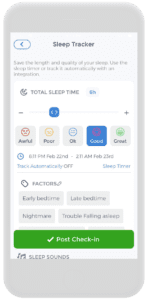
Using the CareClinic Platform and by using the sleep tracker, for instance, there are smiley facial emojis underneath that show “awful”, “poor”, “ok”, “good” and “great”. That way, you can keep track of something very important (such as sleep) with facial ratings! It is an efficient way to describe or visualize something. The platform has expanded on the Wong-Baker concept and can be utilized or expanded to other uses. There may be no clinical evidence supporting this method for this particular use, however, it’s an interactive way to start. Something in the palm of your hands!
Use the platform today to help you stay ahead and also feel free to use the platform as well by sending developers ideas on how to improve or incorporate this function more into other buttons. Start using facial ratings for much more for its intended usage!
Faces Pain Scale Insights
Reviewing a topic that may be completely new to you never hurt. Right? First of all, thank you for reading this far. Cheers! But in all seriousness, now you are somewhat of an expert on what it is, its purpose, when to use it or not use it, and its reliability. The Faces Pain Scale or the Wong-Baker Faces Scale (whatever you want to call it) can be taken into consideration for all your pain needs! In the comfort of your own digital platform! Moving forward digitally will be one of your biggest assets…so congratulations!
Learning more about how you utilize these pain scales or how to incorporate their power as a tool in your life is a great step! You can start your journey by using your iOS or Android devices by downloading the CareClinic Platform for all your healthcare needs today.
References
- Bendinger, T., & Plunkett, N. (2016). Measurement in Pain Medicine. BJA Education, 16(9), 310-315. https://doi.org/10.1093/bjaed/mkw014
- Hicks, C., Baeyer, C., & Spafford, P. (2001). The Faces Pain Scale-Revised: toward a common metric in pediatric pain measurement. International Association for the Study of Pain, 93(2), 173-183. https://doi.org/10.1016/S0304-3959(01)00314-1
- Kim, E., & Buschmann, M. (2006). Reliability and Validity of the Faces Pain Scale with Older Adults. International Journal of Nursing Studies, 43(4), 447-456. https://doi.org/10.1016/j.ijnurstu.2006.01.001
- Middleton, F. (2019, July 3). Reliability vs Validity in Research. Differences, Types, and Examples. https://www.scribbr.com/methodology/reliability-vs-validity/#:~:text=Reliability%20refers%20to%20how%20consistently,the%20measurement%20is%20considered%20reliable.
- , P., , V., , D., & Measurement of pain using the visual numeric scale.
- Singh, A. (n.d.). Faces Pain Scale-Revised and Wong-Baker Pain Rating Scale. Bone and Spine. Retrieved on February 22, 2022, from https://boneandspine.com/faces-pain-scale-revised/.
- Wong-Baker Faces Foundation. (2016). Retrieved on February 22, 2022, from https://wongbakerfaces.org/.


